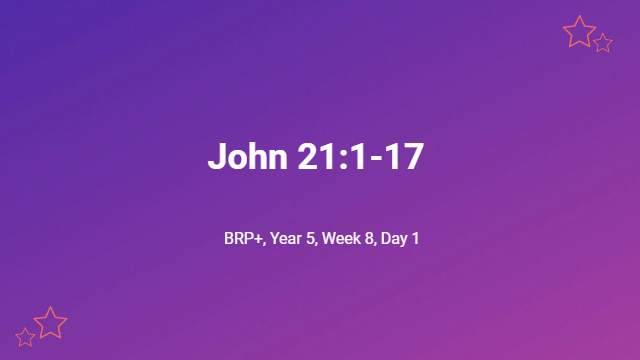John 21:1-17
Q.1. Why did John make this resurrection appearance his most detailed? How do we know that the resurrection of Jesus had not yet transformed the disciples? – (Jn.21:1-3)
Jesus had now appeared several times to various disciples. They were convinced that Jesus had been raised from the dead. However, the issue of their abandonment of Him needed to be faced. In spite of the claims by Peter and the disciples that they would stay true, they had all failed miserably, as Jesus had prophesied. Their feelings of failure expressed themselves in their returning to their previous trade of fishing. They had not forgiven themselves and would be all but useless until their failures had been addressed.
Q.2. How did John conclude that the stranger on the beach was Jesus? What made Peter swim ashore? Who needed the large haul of fish? – (Jn.21:4-11 c.f. Lk.5:4-10)
This was not the first time that the disciples had caught nothing all night. At the beginning of Jesus’ ministry, Peter and Andrew, and James and John had experienced a similar miracle – 4 When He had finished speaking, He said to Simon, “Put out into the deep water and let down your nets for a catch.” 5 Simon answered and said, “Master, we worked hard all night and caught nothing, but I will do as You say and let down the nets.” 6 When they had done this, they enclosed a great quantity of fish, and their nets began to break (Lk.5:4-6). Following this, John had been present when Jesus called Peter – 9 For amazement had seized him and all his companions because of the catch of fish which they had taken; 10 and so also were James and John, sons of Zebedee, who were partners with Simon. And Jesus said to Simon, “Do not fear, from now on you will be catching men.” (Lk.5:9-10). The repeat miracle that netted the disciples one hundred and fifty-three large fish, was too much of a coincidence for John – Therefore that disciple whom Jesus loved said to Peter, “It is the Lord.” So when Simon Peter heard that it was the Lord, he put his outer garment on (for he was stripped for work) and threw himself into the sea (Jn.21:7). This was typical of the way that Peter reacted. John made it clear that the miracle was for them, and not for Jesus Himself, because – when they got out on the land, they saw a charcoal fire already laid and fish placed on it, and bread (Jn.21:9). Jesus needed no fish or bread for their breakfast.
Q.3. What stopped the disciples from asking Jesus to identify Himself? How did Jesus reveal Whom He was? Why did He single Peter out for special questioning? – (Jn.21:12-15 c.f. Mk.14:27-31)
Try to imagine the acute sense of failure that the disciples must have felt after abandoning their Lord and Master in His time of need. Yes, they knew He was alive, but they still did not understand the Scriptures properly (Jn.20:9). They would have been reluctant to be over-familiar. They pretended that nothing had happened. However, they all plainly knew that it was Jesus – 12 … None of the disciples ventured to question Him, “Who are You?” knowing that it was the Lord … 14 This is now the third time that Jesus was manifested to the disciples, after He was raised from the dead (Jn.21:12 & 14). After breakfast, Jesus proceeded to break the stalemate. They had all declared that they would never deny that they belonged to Him. Peter had gone even further and had claimed he was even prepared to die for Jesus (Mk.14:29-31). Peter’s pride had to be dealt with, for him to be restored, and to be useful.
Q.4. What lesson was Jesus trying to drive home to Peter? Why was Peter troubled when Jesus repeated His question a third time? How did Jesus restore Peter’s leadership? – (Jn.21:15-17 c.f. Mt.16:16-19)
The boastful claim of Peter was faced head-on by Jesus – … “Simon, son of John, do you love (Gk. – agapeo) Me more than these?” [i.e. could mean – more than the fishing business or more than the other disciples as he had claimed]. He said to Him, “Yes, Lord; You know that I love (Gk. – phileo) You.” He said to him, “Tend My lambs.” (Jn.21:15). Jesus questioned Peter’s loving devotion with agapeo. Peter had learnt his lesson and would only admit – You know I am your friend (phileo). Jesus purposefully questioned Peter a second … and then a third time. Peter had denied three times that he knew Jesus. However, in the third questioning, Jesus stooped to Peter’s level and asked – …”Simon, son of John, do you love (Gk. – phileo) Me?” Peter was grieved because He said to him the third time, “Do you love (Gr. – phileo) Me?” And he said to Him, “Lord, You know all things; You know that I love (Gk. – phileo) You.” Jesus said to him, “Tend My sheep (Jn.21:17). Peter was bothered when Jesus used phileo. It was like Jesus was asking him – Are you even My friend? Jesus each time re-commissioned Peter – 15 “Tend My lambs…” 16 “Shepherd My sheep…” 17 “Tend My sheep (Jn.21:15-17). Though this command to shepherd other people applied to all His disciples, it was specifically directed at Peter. History shows that Peter took up the mantel of leadership over the apostles and passed on this responsibility to the elders in succeeding generations (1 Pet.5:1-4).

